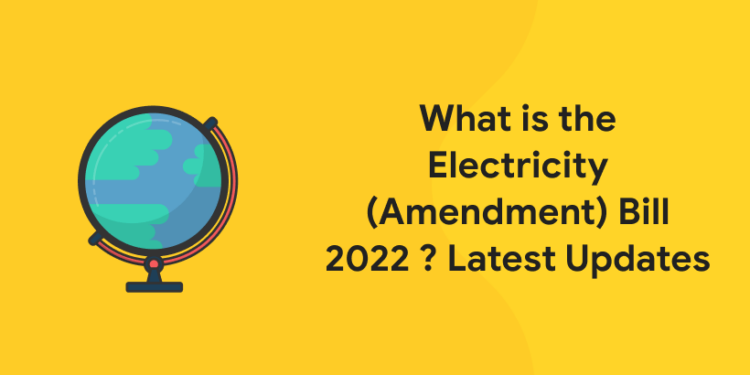Table of Contents
The government Monday submitted the Electricity (Amendment) Bill 2022 in the Lok Sabha, soon after which it was mentioned to the parliamentary standing committee on energy for broad consultation with stakeholders.
Under the amendments proposed, the government is providing consumers an option of power suppliers like mobile and internet service providers. It also has a provision for timely and adequate tariff revisions to allow state utilities come out of losses and make payments for power in-time.
Recently, the Electricity (Amendment) Bill 2022 was introduced in Parliament in the midst of protests and later sent to the standing committee for more deliberation. Many power engineers objected the Bill across the country, in states like Tamil Nadu, Telangana, Rajasthan, and others.
The Electricity (Amendment) Bill, a key bill of the Bharatiya Janata Party (BJP)-led central government, targets to bring changes in India’s power sector. It proposes certain amendments to the Electricity Act, 2003. The bill seeks to delicense the power distribution and allow private sector companies to enter the sector and compete with state-owned firms.
Grab Latest Study Materials! Register Here!
What is the Electricity (Amendment) Bill 2022?
The Electricity Amendment Bill, 2022 targets at giving several players open access to distribution networks of power suppliers and also letting consumers to select any service provider.
Implication:
The Bill looks forward to alter Electricity Act 2003:
- To ease the use of distribution networks by all licensees, under provisions of non-discriminatory “open access” with the objective of enabling competition, enhancing efficiency of distribution licensees for improving services to consumers and ensuring sustainability of the power sector.
- To smoothen non-discriminatory open access to the distribution network of a distribution licensee.
- To make provisions vis-à-vis graded revision in tariff over a year besides mandatory fixing of maximum ceiling and minimum tariff by the appropriate commission.
- To change the rate of punishment from imprisonment or fine to fine.
- To build up functions that will be discharged by the regulators.
What are the Protestor’s Arguments Against the Bill?
Federal Structure:
- The Constitution lists ‘Electricity’ as Item 38 of List III (Concurrent) of the Seventh Schedule, so both the Central and state governments have the control to make laws on this subject.
- With the proposed amendments, the federal structure of Indian polity, a part of the ‘basic structure’ of the Constitution of India, is being violated.
Electricity Subsidy:
- Free power for farmers and Below Poverty Line population will go away eventually.
Differential Distribution:
- Only government discoms or distribution companies will have universal power supply obligations.
- Therefore, it is likely that private licensees will prefer to supply the electricity in profit-making areas – to industrial and commercial consumers.
- Once this takes place, profit-making areas will be seized from government discoms and they will become loss-making companies.
Grab Latest Study Materials! Register Here!
How will this Bill impact the Power Employees & Consumers?
1: Who was the first woman President of India?
Monopoly of Private Players:
- It will result in a major loss for government distribution companies, in due course allowing to establish the monopoly of a few private parties in the country’s power sector.
Operational Issue:
- About 80% of the cost of supply is on account of power purchase, which will be the similar for all distribution licensees operating in an area.
- Having different retailers will open a plethora of operational issues.
- By bringing in more retailers or distribution licensees, the quality of service or price is not going to be any different.
Hit on Consumers:
- According to a report of UK auditors, due to adoption of such wrong models the consumers had to pay in excess of 2.6 billion pounds.
- The cost of such transfers was charged to the ordinary consumer.
- While the private companies failed, consumers were hit the most.
Practise free mock test and ace your government exams! Download Entri App!
- Government has specified that no provision in the bill lessens the powers of the states to control the power distribution sector, payment of power subsidy.
- The government has showed that several discoms can already exist in the same area and the bill only shortens the process to confirm that competition results to better operations and service.
- The government has stated that it had consulted every state and many associations in writing, including a separate written assurance to the Agriculture Ministry, that there is nothing anti-farmer in the bill.
- The bill enables the use of additional cross-subsidy that is collected from industrial and commercial users in one area, for subsidising for the poor in other areas.
- With India targeting to attain 50% of its installed power capacity from renewables by 2030, the government is of the view that the push for Renewable Purchase Obligations (RPOs) mentioned in the bill will augment India’s power demand, which is expected to double in the next eight years while moving to achieve green targets fixed as per the Paris and Glasgow Agreements.
Way Forward
- Being a subject of Concurrent List of Indian Constitution, recommendations from states should be taken into consideration for effective implementation of the provisions of the bill.
- Provision concerned to subsidies should be put up in a detailed manner to eradicate any scope of confusion/ conflict.
- Regulations for private players should be brought in to avoid differential distribution.
The proposed amendment to these Sections will enable the use of distribution networks by all licensees “under provisions of non-discriminatory open access”. The freedom to select will be provided through multiple distribution licensees on the same network. This is significant because while the incumbent Act did let several licensees to function, it did not give them access to the existing power distribution network.
Earlier open-access provisions were damaged by exceptions and legal disputes. In the past, only large consumers were able to select their provider. With this new Bill, Business Standard has argued that consumer rights must be respected through a principle like open access and that its application is overdue. Anyhow, consumer choice will mean that poorly-performing state electricity utilities could end up being shunned in favour of their better-performing counterparts.
The Bill will also alter Section 62 to enable graded revision in tariff over a year. The Bill also says that an appropriate commission will fix the maximum ceiling and minimum tariff. An amendment to Section 166 is also slated to build up the regulators and the functions carried out by them. However, the Centre has dropped the proposal of privatising state-owned power distribution companies.
Practise free mock test and ace your government exams! Download Entri App!
Key specifications of the bill
The bill proposes a framework to allow consumers to choose between different service providers. It provides for the formation of the Electricity Contract Enforcement Authority (ECEA), which will deal with contract-related disputes in the electricity sector. Further, the bill proposes penalties in case of non-compliance by licensees in meeting the obligations. It requires all licensees to purchase or produce a minimum specified quantity from renewable energy sources as a percentage of their total electricity consumption. A selection committee would be constituted to appoint the chairperson and members of the Appellate Tribunal (APTEL), the central and state regulatory commissions (CERC, SERCs) and the ECEA, according to the bill.
A timeline of events
The Electricity Act was passed by the Indian Parliament in 2003. It covers issues related to the generation, distribution, transmission, and trading of power in the country. The Centre is expected to introduce the Electricity (Amendment) Bill in the 2022 monsoon session of the Parliament. The session is due to begin on July 18 and will commence on August 13.
Free UPSKILLING Courses!
Take your first step toward mastering in-demand skills, acing interviews, and securing top-tier jobs with Entri's free upskilling courses.
Start Learning!What is the opposition to the Electricity (Amendment) Bill 2022?
According to Ajaypal Singh Atwal, the General Secretary of Punjab State Electricity Board Engineers Association (PSEBEA), “In this Bill, Section 42 of the Electricity Act will be amended to allow ‘non-discriminatory open access’ to the distribution network, allowing private companies to supply electricity provided they get a license.”
Atwal further said, “Section 14 of the Electricity Act has also been proposed to be amended, allowing private companies to use distribution networks built by public sector electricity companies, enabling competition and enhancing the efficiency of power supply across the country.”
Under the Bill, consumers will be able to choose from multiple electricity providers, essentially like how they choose currently between telecom providers like Airtel, Vodafone, etc., he added. Several bodies and political parties have opposed the Electricity (Amendment) Bill, 2022. Ahead of the monsoon session 2022, the All India Power Engineers’ Federation (AIPEF) wrote to the Union Power Minister R K Singh and Chief Ministers of all states, requesting to stop the bill. The federation suggested the government hold discussions with electricity sector workers and power consumers. The bill faces criticism that it would dilute the power of the states and shift it to the Centre and its agencies. Critics further say the bill allows private players an easy entry into the electricity sector, thus granting them an undue advantage.
Practise free mock test and ace your government exams! Download Entri App!
Protesters claim that as per the Bill, only government discoms or distribution companies will have universal power supply obligations. Therefore, it is likely that private licensees will prefer to supply the electricity in profit-making areas – to industrial and commercial consumers.
Jagtar Singh Dhiman, President of the PSEBEA, said that once this happens, profit-making areas will be snatched from government discoms and they will become loss-making companies. It will be difficult for them to purchase electricity from generators or to undertake infrastructure upgradation, he said.
Another problematic aspect, as per the Bill’s critics and the Chief Minister of Punjab, is that the Constitution lists ‘Electricity’ as Item 38 of List III (Concurrent) of the Seventh Schedule, so both the Central and state governments have the power to make laws on this subject. They said with the proposed amendments, the federal structure of Indian polity, a part of the ‘basic structure’ of the Constitution of India, is being violated.
Labour unions and the Sanyukt Kisan Morcha, an umbrella organisation that was at the centre of the Farmers’ Protests in 2020 and 2021, are of the view that free power for farmers and Below Poverty Line population will go away eventually.
Presently, around Rs 15,000 crores are spent on the various power subsidies that the Punjab government offers. ‘Zero power bills’ or free electricity in the domestic sector are given out if consumption is up to 600 units in two months per family. Around 61 lakh households come under this criterion, for which the subsidy amounts to around Rs 1,800 crore according to Vinod Gupta, the spokesperson of the All Indian Power Engineers Federation.
Practise free mock test and ace your government exams! Download Entri App!












